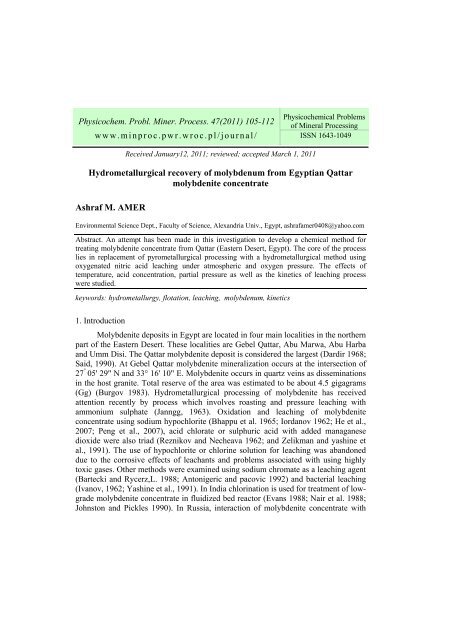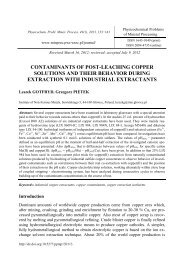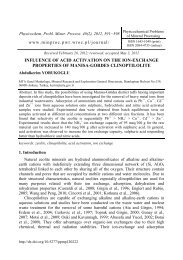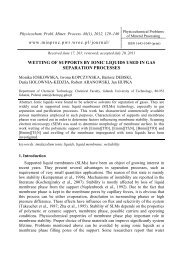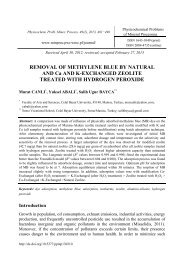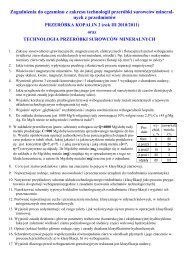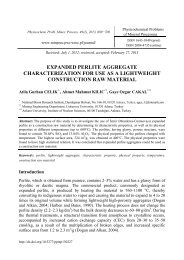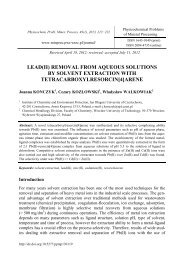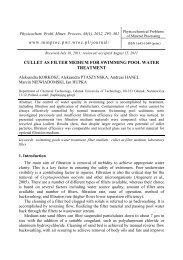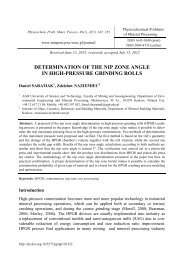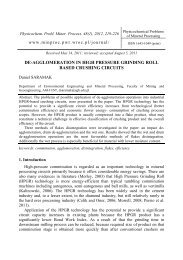Hydrometallurgical recovery of molybdenum from Egyptian Qattar ...
Hydrometallurgical recovery of molybdenum from Egyptian Qattar ...
Hydrometallurgical recovery of molybdenum from Egyptian Qattar ...
You also want an ePaper? Increase the reach of your titles
YUMPU automatically turns print PDFs into web optimized ePapers that Google loves.
Physicochem. Probl. Miner. Process. 47(2011) 105-112<br />
Physicochemical Problems<br />
<strong>of</strong> Mineral Processing<br />
www.minproc.pwr.wroc.pl/journal/ ISSN 1643-1049<br />
Received January12, 2011; reviewed; accepted March 1, 2011<br />
<strong>Hydrometallurgical</strong> <strong>recovery</strong> <strong>of</strong> <strong>molybdenum</strong> <strong>from</strong> <strong>Egyptian</strong> <strong>Qattar</strong><br />
molybdenite concentrate<br />
Ashraf M. AMER<br />
Environmental Science Dept., Faculty <strong>of</strong> Science, Alexandria Univ., Egypt, ashrafamer0408@yahoo.com<br />
Abstract. An attempt has been made in this investigation to develop a chemical method for<br />
treating molybdenite concentrate <strong>from</strong> <strong>Qattar</strong> (Eastern Desert, Egypt). The core <strong>of</strong> the process<br />
lies in replacement <strong>of</strong> pyrometallurgical processing with a hydrometallurgical method using<br />
oxygenated nitric acid leaching under atmospheric and oxygen pressure. The effects <strong>of</strong><br />
temperature, acid concentration, partial pressure as well as the kinetics <strong>of</strong> leaching process<br />
were studied.<br />
keywords: hydrometallurgy, flotation, leaching, <strong>molybdenum</strong>, kinetics<br />
1. Introduction<br />
Molybdenite deposits in Egypt are located in four main localities in the northern<br />
part <strong>of</strong> the Eastern Desert. These localities are Gebel <strong>Qattar</strong>, Abu Marwa, Abu Harba<br />
and Umm Disi. The <strong>Qattar</strong> molybdenite deposit is considered the largest (Dardir 1968;<br />
Said, 1990). At Gebel <strong>Qattar</strong> molybdenite mineralization occurs at the intersection <strong>of</strong><br />
27 ° 05' 29" N and 33° 16' 10" E. Molybdenite occurs in quartz veins as disseminations<br />
in the host granite. Total reserve <strong>of</strong> the area was estimated to be about 4.5 gigagrams<br />
(Gg) (Burgov 1983). <strong>Hydrometallurgical</strong> processing <strong>of</strong> molybdenite has received<br />
attention recently by process which involves roasting and pressure leaching with<br />
ammonium sulphate (Janngg, 1963). Oxidation and leaching <strong>of</strong> molybdenite<br />
concentrate using sodium hypochlorite (Bhappu et al. 1965; Iordanov 1962; He et al.,<br />
2007; Peng et al., 2007), acid chlorate or sulphuric acid with added managanese<br />
dioxide were also triad (Reznikov and Necheava 1962; and Zelikman and yashine et<br />
al., 1991). The use <strong>of</strong> hypochlorite or chlorine solution for leaching was abandoned<br />
due to the corrosive effects <strong>of</strong> leachants and problems associated with using highly<br />
toxic gases. Other methods were examined using sodium chromate as a leaching agent<br />
(Bartecki and Rycerz,L. 1988; Antonigeric and pacovic 1992) and bacterial leaching<br />
(Ivanov, 1962; Yashine et al., 1991). In India chlorination is used for treatment <strong>of</strong> lowgrade<br />
molybdenite concentrate in fluidized bed reactor (Evans 1988; Nair et al. 1988;<br />
Johnston and Pickles 1990). In Russia, interaction <strong>of</strong> molybdenite concentrate with
106 A.M. Amer<br />
nitric acid was investigated (Bjarling, G. and Kolta, G.A. 1964; Chursanov et al.,<br />
1987; Peters, 1992; Zhang (2009); Smirnov et al., 2010).<br />
The objective <strong>of</strong> this investigation is to study nitric acid leaching <strong>of</strong><br />
molybdenite concentrate under atmospheric and oxygen pressure as well as the<br />
kinetics <strong>of</strong> pressure leaching process.<br />
2. Experimental<br />
2.1. Material and Methods<br />
Gebel <strong>Qattar</strong> molybdenite ore occurs in two forms. The fist form, crystals, are<br />
irregularly distributed in the quartz veinlets. They are well developed showing length<br />
variation between 2 to 3 cm. The second form is massive ore at wall rock confined to<br />
areas between molybdenite crystals bearing quartz veins and the granitic host rock.<br />
The chemical composition <strong>of</strong> the investigated Gebel <strong>Qattar</strong> molybdenite concentrate is<br />
given Table 1.<br />
Table 1. Chemical analysis <strong>of</strong> the investigated Gebel <strong>Qattar</strong> molybdenite concentrate<br />
composition percentage (by weight)<br />
Mo 30.2<br />
S 24.3<br />
Ni 0.17<br />
Cu 0.35<br />
Fe 1.62<br />
Si 7.05<br />
Total 99.5<br />
2.2. Apparatus<br />
The pressure leaching experiments were carried out in 2 dm 3 laboratory<br />
autoclave. The autoclave had the following features: a maximum working pressure <strong>of</strong><br />
20.6 MPa temperatures <strong>of</strong> 300°C and stirring speed <strong>of</strong> 1600 rpm. Description <strong>of</strong> used<br />
apparatus is given ells where (Amer, 1996)<br />
Details on leaching experiments in open vessel and in autoclave are given<br />
elsewhere (Amer, 1996).<br />
2.3. Analysis<br />
Molybdenum in solution and in solid samples was analyzed<br />
spectrophotometrically. The technique follows that <strong>of</strong> Jefferry and Justschison (1981)<br />
which was modified by the Chemistry Division <strong>of</strong> the Federal Geological Survey in<br />
Germany.
<strong>Hydrometallurgical</strong> <strong>recovery</strong> <strong>of</strong> <strong>molybdenum</strong> <strong>from</strong> <strong>Egyptian</strong> concentrate 107<br />
3. Results and discussion<br />
3.1. Mineralogical study<br />
X-ray examination along with microscopic investigation <strong>of</strong> representative<br />
molybdenite sample revealed that molybdenite mineral content is about 1%. Quartz<br />
seems to be the main gangue mineral, present mainly as coarse anhedral crystals with<br />
smooth interlocking borders, constitutes about 70 % <strong>of</strong> the sample. Feldspars follows<br />
quartz in abundance. Oligoclase and orthoclase occur as fine to coarse anhedral grains,<br />
occasionally interstitial, or being enclosed in quartz. They form about 17% <strong>of</strong> the<br />
volume in the studied sample. Some micaceous minerals are present as muscovite and<br />
biotite (about 7%). Molybdenite is represented by globular forms having well<br />
developed concentric texture. Molybdenite grains show wide size variation.<br />
3.2. <strong>Hydrometallurgical</strong> processing <strong>of</strong> molybdenite concentrate<br />
3.2.1. Atmospheric leaching<br />
The purpose <strong>of</strong> atmospheric acid leaching <strong>of</strong> molybdenite is to produce a very<br />
pure molybdenite oxide as the ordinary roasting process does not involve any<br />
purification and provide volatilization losses. Leaching <strong>of</strong> molybdenite with aqueous<br />
nitric acid is carried out according to the following reaction:<br />
MoS2 + 6NO - 3 → MoO 2- 4 + 2SO 2- 4 +6NO . (1)<br />
Factors which influence the leaching rate <strong>of</strong> molybdenite are temperature,<br />
leaching time and nitric acid concentration. Results showing the effect <strong>of</strong> these factors<br />
on the leaching <strong>of</strong> molybdenite are illustrated in Figs 1 and 2. Molybdenum extraction<br />
has been found to increase with the increase <strong>of</strong> temperature and leaching time.<br />
Maximum <strong>molybdenum</strong> leaching <strong>recovery</strong> (96%) was reached at temperature <strong>of</strong><br />
100°C after 225 min <strong>of</strong> leaching a time. The effect <strong>of</strong> nitric acid concentration on<br />
<strong>molybdenum</strong> extraction is shown in Fig. 2. Generally as nitric acid concentration<br />
increases <strong>from</strong> 5 to 10 %, the <strong>molybdenum</strong> <strong>recovery</strong> increases at different leaching<br />
times. Practically, an increase <strong>of</strong> the acid concentration more than 10%, especially at<br />
long leaching time <strong>of</strong> 180-225 min had no effect on the <strong>molybdenum</strong> leaching<br />
<strong>recovery</strong>. It could be concluded that under atmospheric leaching conditions the<br />
maximum <strong>molybdenum</strong> extraction <strong>of</strong> 96% is reached under the following conditions:<br />
temperature : 100°C<br />
leaching time : 225 min<br />
nitric acid concentration : 10%<br />
pulp density : 10%.<br />
From these conditions, it appears that the process <strong>of</strong> molybdenite leaching is<br />
slow under atmospheric conditions. For that, a series <strong>of</strong> experiments were carried out<br />
using autoclave to accelerate the rate <strong>of</strong> <strong>molybdenum</strong> <strong>recovery</strong> and to increase Mo<br />
<strong>recovery</strong>.
108 A.M. Amer<br />
The temperature effect on the <strong>molybdenum</strong> leaching <strong>recovery</strong> has been studied<br />
over a temperature range <strong>from</strong> 120° to 200°C and the results are given in Fig. 3.<br />
Molybdenum Leach Recovery, %<br />
Molybdenum leach <strong>recovery</strong>, %<br />
100<br />
90<br />
80<br />
70<br />
60<br />
50<br />
40<br />
30<br />
20<br />
10<br />
100°C<br />
90 o C<br />
Conc. <strong>of</strong> HNO3: 10%<br />
Pulp density: 10%<br />
70 o C<br />
0<br />
0 50 100<br />
Leaching time, min<br />
150 200<br />
Fig. 1. Effect <strong>of</strong> leaching temperature on<br />
<strong>molybdenum</strong> extraction<br />
100<br />
90<br />
80<br />
70<br />
60<br />
50<br />
40<br />
30<br />
20<br />
10<br />
200°C<br />
140 o C<br />
180°C<br />
160 o C<br />
Nitric Acid Conc.: 10%<br />
Pulp density: 10%<br />
0<br />
0 5 10 15 20 25 30 35<br />
Leaching time, min.<br />
Fig. 3. Effect <strong>of</strong> leaching temperature on<br />
<strong>molybdenum</strong> extraction<br />
Molybdenum extraction, %<br />
-ln (1-α)<br />
110<br />
100<br />
90<br />
80<br />
70<br />
60<br />
225min<br />
180 min<br />
90 min<br />
45 min<br />
50<br />
40<br />
Temp: 100°C<br />
Pulp density: 10%<br />
4 6 8 10 12 14<br />
Acid concentration, %<br />
Fig. 2. Effect <strong>of</strong> acid concentration on<br />
<strong>molybdenum</strong> extraction<br />
3.0<br />
2.5<br />
2.0<br />
1.5<br />
1.0<br />
0.5<br />
0.0<br />
160 o C<br />
200°C<br />
180°C<br />
140 o C<br />
10 15 20 25 30 35<br />
Leaching time, min.<br />
Fig. 4. Relation between ln(1-α) and time<br />
It is obvious that the reaction rate increases with increasing temperature and<br />
reaches its maximum value at 200°C (2.9 × 10 3 sec -1 ). As illustrated in Fig. 4 the plot<br />
<strong>of</strong> ln (1-α) versus t over the studied temperature range consists <strong>of</strong> a series <strong>of</strong> straight<br />
lines indicating that leaching <strong>of</strong> molybdenite fits a first order reaction, where slopes <strong>of</strong><br />
these lines gives the rate <strong>of</strong> reaction (K).<br />
An Arrhenius plot is constructed and shown in Fig. 5. The calculated apparent<br />
activation energy is 49 kJ/mol. This value is in a good agreement with the values<br />
reported by Kanome et al. (1987) for capper sulfide and nickel sulfide, respectively.<br />
The obtained value <strong>of</strong> activation energy (49 kJ/mol) is too high for the reaction to be<br />
controlled by mass transfer through the boundary layer but is possible for chemically<br />
controlled reactions (Wadsworth, 1972).
Molybdenum leach <strong>recovery</strong>, %<br />
log k<br />
<strong>Hydrometallurgical</strong> <strong>recovery</strong> <strong>of</strong> <strong>molybdenum</strong> <strong>from</strong> <strong>Egyptian</strong> concentrate 109<br />
2.6<br />
2.7<br />
2.8<br />
2.9<br />
3.0<br />
3.1<br />
3.2<br />
3.3<br />
3.4<br />
3.5<br />
3.6<br />
49 KJ/mol<br />
1.8 2.3 2.8<br />
1/T (103 k-1)<br />
3.3 3.8<br />
Fig. 5. The Arrhenius plot for<br />
determination <strong>of</strong> activation<br />
energy<br />
The effect <strong>of</strong> oxygen partial pressure on <strong>molybdenum</strong> extraction is shown in<br />
Fig. 6. It is obvious that, at different leaching times <strong>of</strong> 15, 20 and 30 min, an increase<br />
<strong>of</strong> oxygen partial pressure <strong>from</strong> 0.5 up to 1.5 MPa leads to a remarkable increase in<br />
the <strong>molybdenum</strong> <strong>recovery</strong> while an increase <strong>of</strong> oxygen partial pressure to more than<br />
1.5 MPa has practically no effect on improving <strong>molybdenum</strong> <strong>recovery</strong>.<br />
Ninety six percent leaching <strong>recovery</strong> <strong>of</strong> <strong>molybdenum</strong> by nitric acid pressure<br />
leaching <strong>of</strong> the molybdenite concentrate seems to be an alternative applicable method<br />
<strong>of</strong> molybdenite processing.<br />
The effect <strong>of</strong> acid concentration on the leaching <strong>recovery</strong> <strong>of</strong> <strong>molybdenum</strong> is<br />
shown in Fig. 7.<br />
Ninety six percent leaching <strong>recovery</strong> <strong>of</strong> <strong>molybdenum</strong> is reached after 30 min <strong>of</strong><br />
leaching time compared with 225 min in case <strong>of</strong> atmospheric leaching. A<br />
technological flow sheet <strong>of</strong> enrichment and processing <strong>of</strong> <strong>Qattar</strong> molybdenite deposits<br />
is given in Fig. 8.<br />
100<br />
80<br />
60<br />
40<br />
20<br />
180°C<br />
160 o C<br />
200°C<br />
0<br />
0.0 0.5 1.0 1.5 2.0 2.5<br />
Oxygen partial pressure, MPa<br />
Fig. 6. Effect <strong>of</strong> oxygen partial reassure on<br />
<strong>molybdenum</strong> extraction<br />
Molybdenum extraction, %<br />
110<br />
100<br />
90<br />
80<br />
70<br />
60<br />
50<br />
30 min<br />
60 min<br />
90 min<br />
120 min<br />
40<br />
0 2 4 6 8 10 12<br />
Acid concentration, %<br />
Fig. 7. Effect <strong>of</strong> acid concentration on<br />
<strong>molybdenum</strong> extraction
110 A.M. Amer<br />
Fig. 8. Flowsheet <strong>of</strong> enrichment and processing <strong>of</strong> <strong>Qattar</strong> molybdenite deposits<br />
4. Conclusions<br />
Pressure leaching <strong>of</strong> molybdenite concentrates with nitric acid represents a new<br />
possible method for processing <strong>of</strong> molybdenite. The most favorable conditions for the<br />
96% leaching <strong>recovery</strong> <strong>of</strong> <strong>molybdenum</strong> under atmospheric conditions are: temperature<br />
<strong>of</strong> 100 0 C, 225 min <strong>of</strong> leaching and nitric acid concentration equal to 10%. The most<br />
favorable conditions for pressure leaching <strong>of</strong> molybdenite to get 96% <strong>recovery</strong> are:<br />
200˚C, 30 min <strong>of</strong> leaching, nitric acid concentration equal to 10% and oxygen partial<br />
pressure 1.5 MPa.<br />
Refrerences<br />
Ang, M.; Wang, X and Liu, W. (2009): A novel technology <strong>of</strong> <strong>molybdenum</strong> extraction<br />
<strong>from</strong> low Ni-Mo are, Hydrometallurgy, Vol. 97, Issues 1-2, PP. 126-130.<br />
Amer, A.M. (1996): leaching <strong>of</strong> a low grade <strong>Egyptian</strong> chramite ore Hydrometallurgy,<br />
43, 307-16.<br />
Arbiter, N.; Fuju, Y,; Hansen, B. and Raja, A. (1975): Surface properties <strong>of</strong><br />
hydrophobic solids. ALCHE Symposium series, 71 (150), 176-82.
<strong>Hydrometallurgical</strong> <strong>recovery</strong> <strong>of</strong> <strong>molybdenum</strong> <strong>from</strong> <strong>Egyptian</strong> concentrate 111<br />
Antonigevic, M.M. and Pacovic, N.V. (1992): Investigation <strong>of</strong> molybdenite oxidation<br />
by sodium dichromate. Miner. Eng. 5 (2), 223-33.<br />
Bartecki, A. and Rycerz, L. (1988): Kinetics and mechanism <strong>of</strong> dissolution <strong>of</strong><br />
synthetic <strong>molybdenum</strong> disulfide MoS2 in bromate solutions. Part I,<br />
hydrometallurgy, 20 (2), 235-48.<br />
Burgov, V. (1983): Technical report on follow-up geochemical operations in the<br />
period 1968-1968-1972. Aswan mineral survey project, Geol. Surv. Egypt.<br />
Bhappu, R.B.; Reynolsd, D.H. and Roman, R.J. (1965): molybdenite <strong>recovery</strong> <strong>from</strong><br />
sulfide and oxide ores. J. Metals, 17, 1199-1205.<br />
Bjarling, G. and Kolta, G.A. (1964): Oxidizing leach <strong>of</strong> sulfide concentrates and other<br />
materials catalyzed by nitric acid. Int. Min. process. Cong. VII.<br />
Chander, S.; Wie, J.M. and Fuerstenau, D.W. (1975): On the native floatability and<br />
surface properties <strong>of</strong> naturally hydrophobic solids. ALCHE symp. Series, 71 (150),<br />
183-8.<br />
Chursanov, Yu. V.; Potashnikov, Yn. M. and Rumyantsev, V.K. (1987): Interaction <strong>of</strong><br />
<strong>molybdenum</strong> disulfide with nitric acid. Isvetn. Met. (9), 56-7.<br />
Dardir, A.A; and Gadalla, S.H.A. (1968): Report on expedition 7168, Eastern Desert.<br />
Geol. Surv. Egypt.<br />
Dardir, A.A.; Abu Zeid, K.M. and Gadalla, S.H.A. (1983): molybdenite deposits <strong>of</strong><br />
Gebel <strong>Qattar</strong> area. Annals. Geol. Surv. Egypt. XIII, 23-37.<br />
Evans, D.F. (1980): Principles <strong>of</strong> extractive metallurgy, Gordon and Breach, New<br />
York, Vol. 2.<br />
He, D-S.; Feng,Q.M, Zhang. L-M. and Lu,Y.P. (2007): An environmentally – friendly<br />
technology o vanadium extraction <strong>from</strong> stone coal. Miner. Eng. 20,PP. 1184-1186 .<br />
Ivanov, V.I. (1962): Role <strong>of</strong> sulfur bacteria in the leaching <strong>of</strong> sulfide ores. Dobl. Akad.<br />
Nauk SSR, 146, 447-9.<br />
Iodavov, K. and Zelikman, A.N. (1962): Kinetics <strong>of</strong> oxidation <strong>of</strong> molybdenite in a<br />
solution <strong>of</strong> NaOCL, Khim. Ind. (S<strong>of</strong>ia) 56, 109-26.<br />
Jangg, G. (1963): Alkalische drucklaugung sulfidischer erze, Z. Erzbergbau<br />
metallhuttenw. 16, 508-14.<br />
Johnston, C. and Pickles, C.A. (1990): Study <strong>of</strong> the reaction <strong>of</strong> <strong>molybdenum</strong> disulfide<br />
with lime and carbon at plasma temperature, Trans. Inst. Min. Metall., 100-4.<br />
Jeffery, P.G. and Hutchinson, D. (1981): chemical methods <strong>of</strong> rock analysis. 3 rd ed.<br />
Oxford: pergmon Press, 379 P.<br />
Kanome, O., Abe, H.; Okuwaki, A. and Okabe, T. (1987): Sulfuric acid Oxygenpressure<br />
leaching <strong>of</strong> Ni3S2 prepared by a wet Process. Hydrometallurgy, 19, 1-9.<br />
Leja, J. (1982): Surface chemistry <strong>of</strong> frith floatation. Plenum Press, New York, 488P.,<br />
Nair, K.U.; Sathiyamoothy, D.; Bose, D.K. and Cupta, C.K. (1988): Processing <strong>of</strong> low<br />
grade Indian molybdenite concentrate by chlorination in fluidized bed reactor. Int.<br />
J. Miner Process. 23 (3-4), 171-80.<br />
Peng, J.R.; Yang, D.J.; Chen, J.X. and Yan, J.F.(2007): Experimental study on<br />
alkaline leaching <strong>of</strong> crude molybdenite under pressure <strong>of</strong> Oxygen.
112 A.M. Amer<br />
Peters, E. (1992); <strong>Hydrometallurgical</strong> process innovation. Hydrometallurgy, Vol.29,<br />
Issue 1-3, pp. 43-55.<br />
Papangelakis, V.G. and Demopoulos, G.P. (1991): Acid pressure oxidation <strong>of</strong> pyrite:<br />
reaction Kinetics, Hydrometallurgy, 26, 309-25.<br />
Pesic, B. (1984): Dissolution <strong>of</strong> bornite in sulfuric acid using oxygen oxidant.<br />
Hydrometallurgy, 12, 195-215.<br />
Reznikov, A.A and Necheava, A.A. (1962): Oxidation <strong>of</strong> molybdenite, Inform. Sb.<br />
Vses. Nauchn. Issled. Geol, Inst., 56, 109-26.<br />
Said, R. (1990): The geology <strong>of</strong> Egypt. Balkema: Rotterdam, 525-29.<br />
Somasundaran, P. and Anantapadmanabhan, K.P. (1979): Physico-Chemical aspects<br />
<strong>of</strong> floatation. Trans. Indian Inst. Met., 32, 177-97.<br />
Smirnov, K.M.; Raspopov, N.A. Shneerson, Y.M., Lapin, A.Y.; Bitkov, G.A.;<br />
Menshikov, Y. A., Paskhin, P.N. and Kinehenko, v.p. (2011) Autoclave leaching <strong>of</strong><br />
Molybdenite concentrates with catalytic attitives <strong>of</strong> nitric acid. Russian Metallurgy<br />
(Metally). Vol. 20,Issue 7,pp.58-95.<br />
Wakamatsu, T. and Numate, Y. (1991): Floatation <strong>of</strong> graphite, Min. Eng. (4), 975-82.<br />
Wadsworth, M.E. (1972): Rate processes in hydrometallurgy, Second Tutorial Symp.<br />
On extractive metallurgy, AIME, Salt Lake City, Utah.<br />
Yashina, G.M.; Kostareva, M.A. and Nesterova, S.V. (1991): Leaching <strong>of</strong> Copper –<br />
<strong>molybdenum</strong> ores by chemical and biochemical methods. Fiz. Tekh. Probl. Razrab.<br />
Polezn. Iskop. (6), 93-7.<br />
Yashina, G.M.; Kostareva, M.A. and Kameav, V.D. (1991): Prospects for leaching <strong>of</strong><br />
<strong>molybdenum</strong> – containing ores. Tsv. Met. (16), 13-5.<br />
Zhan. Fang Cao; Hang Zhang; Zhao-hui Oui, Guang – y Liu and Wen-xian Zhang<br />
(2009); A novel technology for Molybdenum extraction <strong>from</strong> Molybdenite<br />
concentrate. Hydrometallurgy , Vol.99, issues 1-2, pages 2-6.


